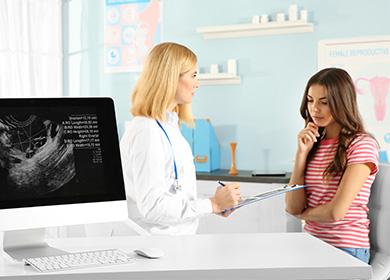The content of the article
Diseases of the reproductive system always require close attention. Cystadenoma is a diagnosis that frightens women. But the methods of modern medicine allow you to get rid of pathology on time in an operational way and even leave a chance to become a mother.
Classification and causes
A cyst of the left or right ovary is diagnosed in women of different ages and affects their reproductive function. Previously, the pathology was called a cyst and always involves bilateral removal of the ovaries. Now surgery with such a neoplasm, if done on time, allows a woman to become pregnant in the future - the tissues of the ovary are preserved.
Varieties
Depending on the structure of the epithelial wall, cystadenoma has the following varieties.
- Serous. Smooth-walled, is the most common form of cystoma. It is mainly found in the form of a rounded single-chamber capsule and affects only one ovary. A two-sided similar process should always be alarming towards malignancy. The average sizes vary from 3 to 15 cm. A cyst with a diameter of less than 3 cm often does not make itself felt by severe symptoms. Sometimes there are neoplasms about 30 cm in size.
- Papillary. It is characterized by the presence of parietal papillary growths. If there are several neoplasms and they are concentrated in a cyst, it is rather difficult to diagnose such a pathology. Symptoms of this type of formation are similar to signs of cancer, therefore the concept of "borderline ovarian cystadenoma" is often used. Treatment may be supplemented by chemotherapy or repeated surgery.
- Mucinous. A benign neoplasm, which includes several chambers filled with a gel-like liquid - mucin. The epithelial lining of this cyst resembles the epithelium of the cervical canal, which is why it is filled with similar mucus. Cystic formation can reach impressive sizes - up to 50 cm. Most often found in women after menopause.
Nature of education
At the moment, it was not possible to establish specific causes of the development of cystadenoma. Most specialists are inclined to believe that the neoplasm arises from serious hormonal disorders or complications after inflammation of the appendages.
However, there are a number of likely factors that provoke the development of the disease. These include:
- early menarche (first menstruation);
- ovarian dysfunction;
- past stresses;
- excessive physical and emotional stress;
- prolonged lack of sexual activity;
- sexually transmitted and infectious diseases;
- ectopic pregnancy;
- abuse of hormonal contraceptives;
- abortions, surgical interventions on the appendages.
The most common is the following theory of the origin of cystadenoma. Functional formations on the ovaries, which include the follicular and the cyst of the corpus luteum, periodically appear and dissolve, which is due to a special cell layer in their wall. This process is allowed even in healthy women. Over time, the number of cells responsible for cyst regression decreases along with the ability of such formations to dissolve independently. As a result, cystadenomas form. Depending on the accompanying processes, they may have a serous, mucinous or papillary structure.

Signs of a tumor
Signs of a neoplasm are manifested along with its growth. These include the following.
- Discomfort. As the tumor grows in the lower abdomen, aching and pulling pains begin to disturb. They can give to the lower back and pubic area. As the neoplasm grows, bursting sensations arise in the peritoneum. Pain during sexual intercourse and during physical exertion are characteristic.
- Destabilization of the menstrual cycle. It can be irregular critical days or their complete absence for several months, heavy, meager or non-functional spotting.
- Frequent urination and constipation. Growing cystadenoma puts pressure on the bladder, resulting in more frequent trips to the toilet. They are not accompanied by pain or pain, as with cystitis or urethritis. The effect of the neoplasm on the intestines violates peristalsis and complicates the emptying.
- Belly enlargement. Significant growth of the cyst leads to an increase in waist circumference. In this case, the tumor can be palpated through the anterior abdominal wall. Such dimensions of the formation are dangerous because a torsion of the legs or a capsule may burst, as a result of which cystic fluid enters the abdominal cavity, peritonitis develops. The condition requires immediate surgical intervention.
Diagnostics
Usually, the disease manifests itself when the diameter of the tumor exceeds 3-4 cm. Prior to this, the cyst is almost always asymptomatic. To detect cystadenoma and clarify its nature can be the methods presented in the table.
Table - Diagnosis of cystadenoma
| Method | What shows |
|---|---|
| Gynecological examination | - Education in the field of appendages; - dimensions, contour, density; - communication with tissues of nearby organs |
| Ultrasound Diagnostics | - Location and size of the cyst; - density and degree of growth of the surface layer; - internal structure, chambers, growths; - signs of malignant growth |
| CT and MRI | - The structure of the neoplasm; - liaison with other bodies; - malignant or benign growth |
Additional research:
- general blood analysis - shows changes in inflammation of the cyst, malignant growth;
- blood on tumor markers - CA-125, ROMA index, HE-4 increase with a malignant tumor;
- fibrogastroscopy and fibrocolonoscopy- Metastases in the gastrointestinal tract are often found.
Treatment
It is possible to eliminate the neoplasm only through surgical intervention. Before the operation, a complex of studies is carried out in order to establish the type of cystadenoma, its size and stage of development. These indicators determine which access and type of intervention is preferable.
- Laparoscopy. Using special tools in the tissues of the anterior abdominal wall, two parallel punctures are performed through which manipulators are inserted. With their help, cystic fluid is first sucked up, and then its tissues are removed. This procedure is less painful, the rehabilitation period passes faster. Also after it is less likely to form adhesions and rough scars.
- Laparotomy This manipulation involves one large incision in the abdomen (transverse or longitudinal, depending on the size and location of the tumor) for full access to the cystadenoma. It is applicable with an advanced stage of the disease and a significant size of the neoplasm, with suspected malignancy.
If the diameter of the cyst capsule does not reach 3 cm, there is a chance to preserve the woman's ovary and reproductive function. In the case when the size of the tumor is larger, the capsule shell “absorbs” the ovary, and it has to be removed. With the benign nature of the neoplasm, the prognosis of recovery is favorable. The volume of surgical intervention is presented in the table.
Table - Volume of surgical intervention
| Transaction volume | Indications |
|---|---|
| Removing only cysts | - Small size of the tumor; - young age of the patient; - absence of signs of malignant growth |
| Biopsy of another ovary | - Violation of the structure; - cystic changes |
| Unilateral adnexectomy | - Large tumor sizes; - lack of intact ("healthy") ovarian tissue |
| Bilateral adnexectomy | - Change and another ovary, its inferiority; - postmenopause (even with normal structure) |
| Peritoneal resection supplement | Malignant Suspicion |
| Removal of the uterus and appendages | Clear malignant growth |
A planned surgical intervention is performed if the diameter of the cyst is 6-10 cm and if a neoplasm is suspected to degenerate into a malignant tumor. In other cases, an individual approach.
Indications for emergency removal
It is better when the removal of cystoma is performed as planned. Indications for emergency surgery:
- inflammation due to suppuration of the cyst;
- torsion of the legs of formation and tissue necrosis;
- rupture of a cyst.
Contraindications to surgery
There are factors in which you should not promptly remove the tumor due to certain risks. Contraindications are taken into account if there is no need for urgent surgery and the size of the cyst is relatively small (this indicator is determined by a specialist individually).
Risk factors include:
- infectious diseases in a chronic form or acute stage;
- impaired blood coagulation;
- operational manipulations, from the moment of which six months have not passed;
- insufficiency of lung and heart function;
- obesity above the second degree;
- adhesions of the peritoneal organs;
- internal bleeding;
- heart attack, stroke;
- purulent peritonitis;
- pregnancy.

Folk methods
Cystadenoma can only be cured by surgical removal. But as an additional supportive therapy, folk remedies are often used.
- Tincture of green hazel. A quarter-liter can is filled with young fruits of walnuts for a quarter, poured under the lid with alcohol and infused in a dark place for a month. It is taken twice a day for one tablespoon in a course of 30 days.
- Acacia Tincture. Four tablespoons of the flowers of the plant are poured with 0.5 liters of alcohol, infused for a week. You should drink one tablespoon three times a day for a month.
Conservative therapy
Antibacterial and complex anti-inflammatory therapy is carried out. Vitamins are also prescribed. This is acceptable for small formations (up to 3 cm in postmenopausal women and up to 6 cm in reproductive age), without growth according to the results of the annual dynamic observation and with normal indicators of tumor markers.
Troubling signs
The following symptoms should be the reason for close medical attention and serious treatment:
- increase of tumor markers - malignant growth is indicated by an increase of tens and hundreds of times, insignificant can be with endometrioid cysts, with inflammation;
- ultrasound suspicion - if parietal growths, heterogeneous structures, multichamber, effusion in the abdominal cavity are detected;
- clinical data - pain in the lower abdomen, weakness, lethargy, fatigue and other signs of intoxication of the body.
Like any disease, an ovarian cyst is easier to prevent than to operate. To do this, it is worth observing some simple rules. It is important to avoid the factors that trigger the development of the disease. It is necessary to regularly undergo gynecological examinations and timely treat sexual diseases. Look at the photos and videos, you can also find out more information later. In severe course menopause use hormone replacement therapy as prescribed by your doctor.

